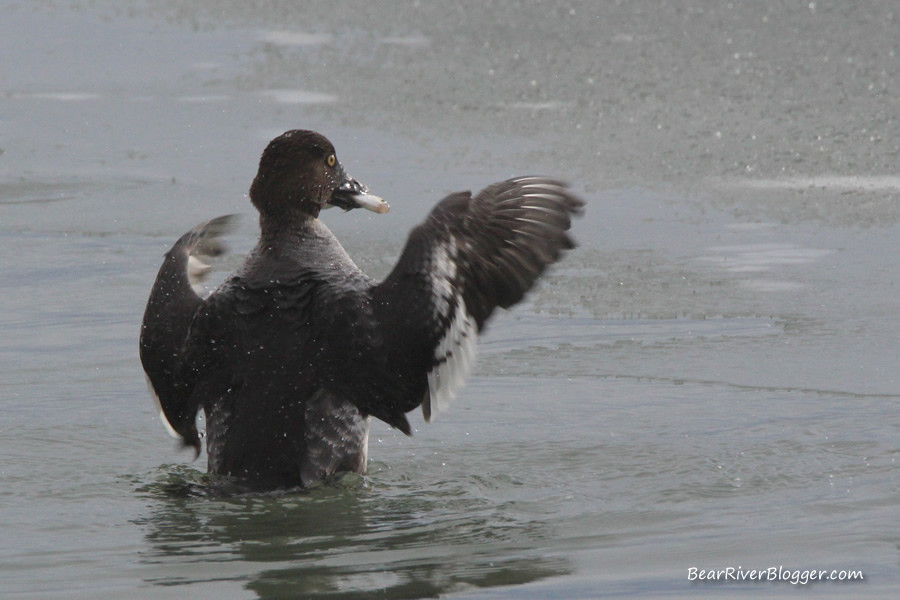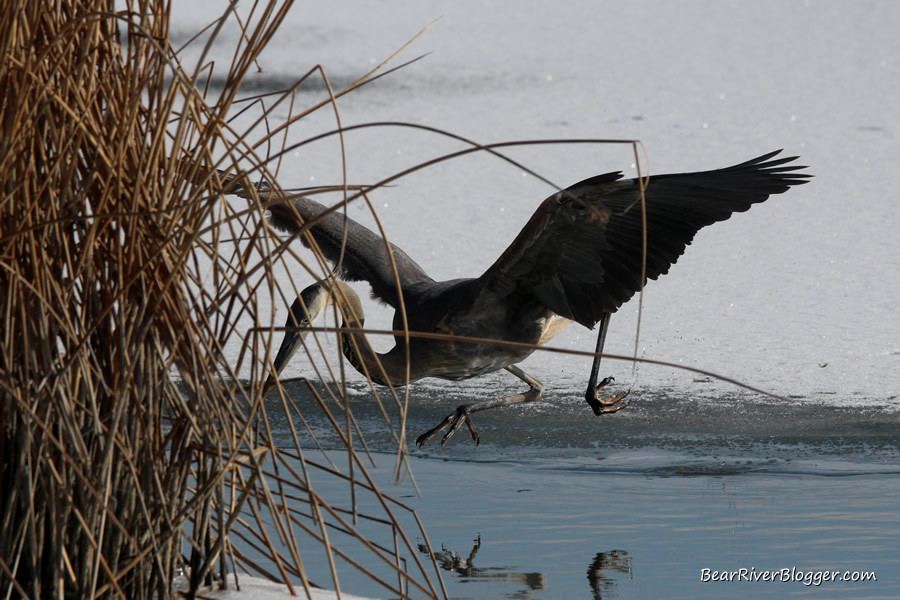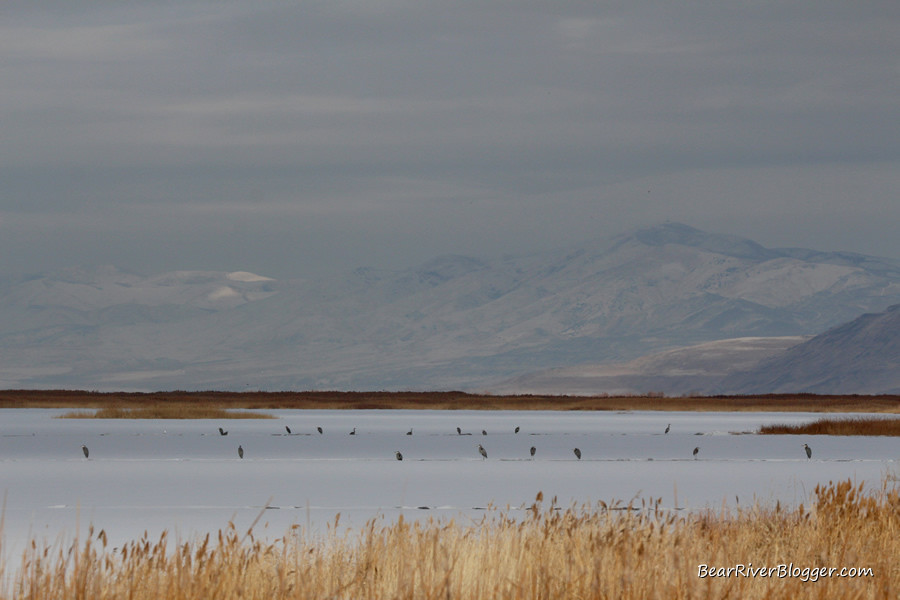Do Herons Fly South For The Winter? Yes, some heron populations do migrate south for the winter, while others adapt and remain in their northern habitats. Flyermedia.net delves into the captivating world of heron migration, exploring how these adaptable birds navigate winter’s challenges. Learn about heron migration habits, winter survival strategies, and the factors influencing their seasonal movements.
1. Great Blue Heron Migration: Do They All Fly South?
Great blue herons are not a migratory species. The decision to migrate depends on several factors, including geography and access to resources.
Some great blue heron populations do migrate for the winter, particularly those in northern regions east of the Rocky Mountains. These herons may fly as far south as Central America, the Caribbean, and northern South America. However, great blue herons west of the Rockies, including those along the Alaskan coastline, generally do not migrate, opting instead to move within their home range in search of open water and food sources.
 Great Blue Heron in Flight Against a Dramatic Sky
Great Blue Heron in Flight Against a Dramatic Sky
2. How Do Great Blue Herons Survive Winter?
Great blue herons primarily survive winter through dietary adaptation and strategic hunting. They are opportunistic feeders, meaning their diet isn’t limited to fish.
2.1 Dietary Flexibility
Great blue herons exhibit remarkable dietary flexibility, enabling them to thrive even when their primary food source, fish, becomes scarce. During winter, when bodies of water freeze over, herons supplement their diet with alternative prey such as:
- Rodents
- Small birds
- Reptiles
- Insects
2.2 Hunting Strategies
Great blue herons employ various hunting strategies to secure food during winter. These include:
- Ice Fishing: Herons patiently stand near small openings in the ice, waiting for fish to swim within striking distance.
- Scavenging: As observed on the Bear River Migratory Bird Refuge, herons may scavenge for fish dropped by other birds, such as common golden-eye ducks.
- Opportunistic Hunting: Herons seize opportunities to hunt available prey, including rodents and birds, adapting their hunting techniques to the prevailing conditions.
2.3 Habitat Selection
Great blue herons strategically select habitats that offer access to food and shelter during winter. They often congregate around:
- Open Water Pockets: Herons seek out areas with small currents or warm water sources that prevent freezing, providing access to fish.
- Sheltered Areas: Herons utilize areas with vegetation or other natural features that offer protection from harsh weather conditions.
3. Where Do Great Blue Herons Go In The Winter Months?
Great blue herons exhibit varying migration patterns, with some populations migrating south and others remaining in their northern habitats. The specific destinations of migrating herons depend on factors such as geographic location and resource availability.
3.1 Migratory Destinations
Great blue herons that migrate south for the winter may travel to:
- Central America
- The Caribbean
- Northern South America
3.2 Non-Migratory Behavior
Great blue herons west of the Rocky Mountains, including those in Alaska, generally do not migrate. Instead, they move within their home range, seeking out areas with open water and food sources. These herons may travel short distances to nearby rivers, lakes, or coastal areas in search of suitable habitat.
4. What Do Great Blue Herons Eat During The Winter Season?
Great blue herons primarily eat fish, but they are also opportunistic feeders and will eat other animals if fish are not available.
4.1 Primary Food Source: Fish
During winter, great blue herons primarily feed on fish when available. They employ various hunting techniques to capture fish in open water pockets or along the edges of frozen bodies of water.
4.2 Alternative Food Sources
When fish are scarce, great blue herons supplement their diet with alternative food sources such as:
- Rodents
- Small birds
- Reptiles
- Insects
- Amphibians
- Crustaceans
4.3 Opportunistic Feeding
Great blue herons are opportunistic feeders, meaning they will take advantage of any available food source. They may scavenge for scraps, steal food from other animals, or hunt prey that is readily accessible. This adaptability allows them to survive in a variety of environments and conditions.
 Great Blue Heron with a Fish in Its Beak
Great Blue Heron with a Fish in Its Beak
5. Great Blue Heron Adaptations: How Do They Survive Freezing Temperatures?
Great blue herons survive freezing temperatures through a combination of physiological and behavioral adaptations. These adaptations enable them to conserve energy, stay warm, and find food in harsh winter conditions.
5.1 Physiological Adaptations
Great blue herons possess several physiological adaptations that help them survive freezing temperatures:
- Insulating Plumage: Their dense plumage provides insulation, trapping body heat and reducing heat loss.
- Countercurrent Heat Exchange: Blood vessels in their legs are arranged in a countercurrent system, allowing heat to be transferred from warm arterial blood to cold venous blood, minimizing heat loss through their extremities.
- Shivering: Great blue herons can shiver to generate heat, increasing their metabolic rate and raising their body temperature.
5.2 Behavioral Adaptations
In addition to physiological adaptations, great blue herons exhibit several behavioral adaptations that help them survive freezing temperatures:
- Roosting in Sheltered Areas: Herons roost in sheltered areas, such as dense vegetation or near thermal cover, to reduce exposure to wind and cold.
- Sunbathing: Herons may sunbathe to absorb solar radiation, warming their bodies and conserving energy.
- Huddling: In some cases, great blue herons may huddle together to share body heat, particularly during extremely cold weather.
- Reducing Activity: Herons may reduce their activity levels during cold weather to conserve energy, minimizing movement and foraging efforts.
6. Are Great Blue Herons Solitary Birds?
Great blue herons are generally solitary feeders, but they may congregate in loose flocks during winter to access open water and foraging opportunities.
6.1 Solitary Feeding Behavior
Great blue herons typically hunt and feed alone, quietly stalking shallow waters in search of prey. They are territorial and will often chase away other herons that intrude on their feeding areas.
6.2 Winter Flocking Behavior
During winter, great blue herons may form loose flocks around open water pockets or other areas with abundant food resources. These flocks are not tightly knit and individuals still maintain a degree of independence.
6.3 Social Interactions
While generally solitary, great blue herons may engage in social interactions, such as:
- Courtship Displays: During breeding season, herons perform elaborate courtship displays to attract mates.
- Territorial Disputes: Herons may engage in territorial disputes with other herons to defend their feeding areas.
- Cooperative Foraging: In rare cases, herons may engage in cooperative foraging, working together to flush out prey.
 Great Blue Heron Standing in Shallow Water
Great Blue Heron Standing in Shallow Water
7. Great Blue Heron Habitat: Where Can You Find Them?
Great blue herons are found in a variety of habitats throughout North and Central America, as well as the Caribbean and the Galapagos Islands. They inhabit both freshwater and saltwater environments, including:
- Marshes
- Swamps
- Mangrove forests
- Lakes
- Ponds
- Rivers
- Coastal areas
7.1 Habitat Preferences
Great blue herons prefer habitats with shallow water, abundant food resources, and suitable nesting sites. They often nest in colonies, known as heronries, which may be located in trees, shrubs, or on the ground.
7.2 Seasonal Habitat Use
Great blue herons may use different habitats depending on the season. During breeding season, they congregate in heronries near water sources. During winter, they may move to areas with open water and access to alternative food sources.
7.3 Distribution
Great blue herons are widely distributed throughout their range, with populations found in both urban and rural areas. They are adaptable and can tolerate a variety of environmental conditions, making them one of the most common and widespread heron species in North America.
8. Observing Great Blue Herons: Tips for Bird Watching
Observing great blue herons in their natural habitat can be a rewarding experience. Here are some tips for bird watching:
8.1 Timing
The best time to observe great blue herons is during early morning or late afternoon when they are most active. They can be seen foraging for food in shallow waters or perched on trees or branches near water sources.
8.2 Location
Great blue herons can be found in a variety of habitats, including marshes, swamps, lakes, ponds, and coastal areas. Look for areas with shallow water, abundant food resources, and suitable nesting sites.
8.3 Equipment
Bring binoculars or a spotting scope for a closer look at the herons. A field guide can help you identify different species of herons and other birds in the area.
8.4 Patience
Be patient and observant. Great blue herons are often solitary and may be difficult to spot at first. Take your time and scan the area carefully, looking for movement or unusual shapes.
8.5 Respect
Respect the birds and their habitat. Do not disturb nesting colonies or approach herons too closely. Observe them from a distance and avoid making loud noises or sudden movements.
9. Great Blue Heron Conservation: Protecting Their Future
Great blue herons are relatively common and widespread, but they face several threats that could impact their populations in the future. These threats include:
- Habitat loss and degradation
- Pollution
- Climate change
- Human disturbance
9.1 Habitat Protection
Protecting and restoring heron habitats is crucial for ensuring their long-term survival. This can be achieved through:
- Conserving wetlands and other important habitats
- Reducing pollution and improving water quality
- Managing human activities in heron habitats
9.2 Monitoring
Monitoring heron populations and their habitats can help identify potential problems and inform conservation efforts. This can be achieved through:
- Conducting regular surveys of heron populations
- Monitoring habitat conditions and water quality
- Tracking heron movements and behavior
9.3 Education
Educating the public about great blue herons and their conservation needs can help raise awareness and encourage support for conservation efforts. This can be achieved through:
- Providing information about great blue herons through websites, brochures, and other educational materials
- Organizing bird watching tours and other educational activities
- Encouraging responsible bird watching practices
 Flock of Great Blue Herons on the Ice
Flock of Great Blue Herons on the Ice
10. Explore More About Herons and Aviation at Flyermedia.net
Flyermedia.net offers a wealth of information for aviation enthusiasts and bird lovers alike.
10.1 Aviation Insights
Discover the latest news, insights, and resources related to aviation, including:
- Pilot training programs
- Aviation regulations and safety
- Aircraft technology and innovation
- Career opportunities in aviation
10.2 Bird Watching Resources
Enhance your bird watching experience with Flyermedia.net’s comprehensive resources, including:
- Bird identification guides
- Bird watching tips and techniques
- Information about bird habitats and conservation
- Bird-related news and events
10.3 Connect with the Community
Join Flyermedia.net’s community of aviation enthusiasts and bird lovers to share your experiences, ask questions, and connect with like-minded individuals.
10.4 Call to Action
Ready to take your aviation or bird watching journey to new heights? Visit Flyermedia.net today to explore our comprehensive resources, connect with our community, and unlock a world of knowledge and inspiration.
Address: 600 S Clyde Morris Blvd, Daytona Beach, FL 32114, United States
Phone: +1 (386) 226-6000
Website: flyermedia.net
FAQ: Great Blue Heron Migration
1. Do all great blue herons migrate south for the winter?
No, only some populations of great blue herons migrate south for the winter. Those that live east of the Rocky Mountains tend to migrate as far as Central America, the Caribbean, or northern South America.
2. Where do great blue herons that don’t migrate spend the winter?
Great blue herons that don’t migrate, such as those west of the Rockies, stay within their home range, moving to find open water and food sources.
3. What do great blue herons eat during the winter?
While their primary food is fish, great blue herons are adaptable and will also eat rodents, small birds, reptiles, and insects when fish are scarce.
4. How do great blue herons adapt to cold winter conditions?
Great blue herons have several adaptations, including dense plumage for insulation, a countercurrent heat exchange system in their legs, and the ability to shiver for warmth. They also use behavioral adaptations like roosting in sheltered areas and sunbathing.
5. Are great blue herons social birds during the winter?
Great blue herons are generally solitary feeders but may gather in loose flocks near open water sources during the winter.
6. What kind of habitats do great blue herons prefer?
Great blue herons prefer habitats with shallow water, abundant food, and suitable nesting sites, such as marshes, swamps, lakes, and coastal areas.
7. What are some tips for observing great blue herons?
To observe great blue herons, go out during early morning or late afternoon, look for areas with shallow water, bring binoculars, and be patient and respectful of their habitat.
8. What threats do great blue herons face?
Great blue herons face threats such as habitat loss, pollution, climate change, and human disturbance.
9. How can we help protect great blue herons?
We can help protect great blue herons by supporting habitat conservation, reducing pollution, monitoring heron populations, and educating others about their conservation needs.
10. Where can I find more information about great blue herons and aviation?
Visit flyermedia.net to discover more about great blue herons, aviation, and other related topics.
